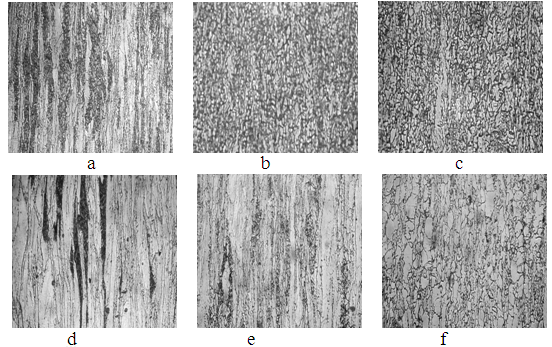Abstract
Low alloy steel controlled rolling are widely used for the production of large-diameter pipes for oil and gas pipelines. In recent decades have been significant developments in the creation of new systems of alloying steels for the production of pipes. The urgency of the work on creation of new types of steels due to their use in the construction of critical applications. In the development of steels tend to improve the chemical composition and technology production of steel pipe, which will provide high strength, ductility, toughness, combined with improved weldability. However, development has become impossible to separate the development of controlled rolling technology, whose main task, as the final stage of technological conversion, is to obtain a dispersed structure, which together with the carbonitride hardening provides a favorable balance of strength, plastic and viscous properties.
Header pipe during operation, working in an environment substantially different from those of other metal structures. This is due to harsh climatic conditions of their application areas, the influence of the permanent (gas) or cyclic (oil) loads as well as the accumulation of large amounts of elastic energy of compressed gas. Great efforts have been directed at developing the theory of reliability of the gas lines. In order to prevent brittle and ductile avalanche damage to the pipes strict requirements on the mechanical properties and resistance emergence and spread of cracks.
strength of pipelines and their operational reliability characteristics determined by the level and quality of the pipes, as well as the level loads, caused by the internal pressure of the transported substances. Requirements for metal pipe are reduced to that he should have as high strength (Tensile strength, because it is the main settlement characteristic), and have a viscosity of viscous resistance and brittle fracture at temperatures of construction and operation, and have good ductility and weldability.
The material used for research data on the chemical composition, process parameters and mechanical properties sheets of steel 10G2FB obtained by controlled rolling. Analyzed the change in mechanical properties of the following indicators: yield strength (YS, N/mm2), ultimate tensile strength (TS, N/mm2), impact strength at negative temperatures (KCV-20 0C, KCU-60 0C). The samples of steel grades X70 and X65 studied the microstructure of the cross section.
Figure 1 shows the microstructure of the steel X70 and X65 in various zones across the thickness of sheets.

a,d- microstructure of the steel in the surface area of the sheet, b, e- at 5 ... 7 mm from the surface,
c, f - in the center section of the thickness of sheet: x500
Figure 1 - The microstructure of steel X70 (a, b, c) and X65 (d, e, f)
Steel structure is primarily ferrite-bainite, following the implementation of accelerated cooling. Bainite is formed instead of perlite, which would form the structure in the case of posledeformatsionnogo cooling in air. Characterized by the presence of structural inhomogeneities in the form of structural banding when alternate bands of ferrite and bainite. The degree of structural heterogeneity is reduced with increasing distance from the surface of the sheet. As a consequence of the structural heterogeneity over the cross section sheets may be traced the anisotropy of mechanical properties. In the near-surface zone of sheets to a depth of 2-3 mm. structure is observed, characterized by the presence of deformed ferrite grains, alternating with bands of bainite (dark bars). For the ferrite grain boundaries and in a relatively small amount - within the grains, observed separation of carbides.
Below are the regression equation describing the change in the mechanical properties of steel 10G2FB depending on the chemical composition and controlled rolling parameters. As the parameters taken into account in the equations are used: average mass temperature of heating slab (Tamt,0C), duration of heating in the oven, the temperature of the end of the roughing rolling (Te.r.,0C), the onset temperature (To.f, 0 C) and end (Te.f,0C) in the finishing rolling mill stand.
Mechanical properties:
TS=1168,23+610,13[C]+35,11[Mn]+106,28[Si]-1100,32[S]-242,45[P]+331,63[Al]-375,31[Mo]+72,53[V]+
+460,33[Nb]-218,76[Ca]+0,14[Тamt]+4,43[to]+0,04[Тe.r]-0,75[Тo.f]-0,53[Te.f]±14,N/mm2;R=0,70
YS=875,2+356,22[C]+39,2[Mn]+84,14[Si]-1325,01[S]-6,17[P]+375,51[Al]-412[Mo]-106,54[V]+436,28[Nb]-
-73,7[Ca]+0,18[Тamt]+3,1[to]+0,02[Тe.r]-0,44[Тo.f]-0,58[Тe.f]±14,N/mm2;R=0,58
From the analysis of equations that is positive for tensile strength and yield strength of the influence of such elements, as C, Mn, Si, Al, Nb, that is, with increasing concentrations of these elements in the studied range, the rate increases. The negative impact on the strength characteristics have a S & P, and Mo, and Ca. Vanadium can have a positive impact on aircraft but negative on Fri As for the technological parameters of rolling, the strength increase is observed with increasing Tamt, tо. Increasing To.f and Te.f promotes softening of steel.
Viscosity indices were:
KCV =-1115,55-695,68[C]+153,96[Mn]-5,5[Si]-6705,26[S]-684,56[P]+122,21[Al]+2480[Mo]-633,49[V]-
-332,93[Nb]+4718,35[Ca]-0,26[Тamt]-4,4[to]-0,02[Тe.r]+1,07[Тo.f]+1,01[Te.f]±39, J/cm2;R=0,56
KCU=-1052,74-883,1[C]+117,33[Mn]-61,17[Si]-5293,02[S]+302,54[P]+518,48[Al]+1230,36[Mo]-510,38[V]-
-482,5[Nb]+5526,5[Ca]-0,08[Тamt]-0,96[to]-0,11[Тe.r]+1,42[Тo.f]+0,47[Te.f]±40, J/cm2; R=0,51
As can be seen from these equations, higher impact strength at low temperatures can be expected at higher concentrations were: Mn, Al, Mo, Ca, but the decrease in the content of C, S, V, Nb. Increasing rates of viscosity can be achieved by increasing Тo.f and Te.f and reduce Tamt, to, Тe.r. The differences in the impact on the performance KCV-20 0C, and KCU-60 0C are Si and P, increase in the content of which contributes to KCU-60 0C, but causes a decrease in KCV-20 0C.
References
- Дорохин В.М. Оценка анизотропии механических свойств и трещи-стойкости листов и труб большого диаметра / В.М. Дорохин, В.П. Горбатенко, Ю.Д. Морозов, Г.А. Филиппов, О.Н. Чевская, С.Ю. Лях //Сталь.-2001.-№1.-С.65-69.
- Остсемин А.А. Трещиностойкость и ударная вязкость прямо- и спиральношовных труб / А.А. Остсемин, В.Л. Дилльман //Сталь.-2001.-№ 10.-С.44-48.
- Матросов Ю.И. Разработка и технологический процесс производства трубных сталей в ? ?І веке / Ю.И. Матросов, Ю.Д. Морозов, А.С. Болотов, Ф. Хайстеркамп // Сталь.-2001.-№ 4.-С.58-62.
- Проблемы совмещения горячей деформации и термической обработки стали / А.А. Баранов, А.А. Минаев, А.Л. Геллер, В.П. Горбатенко –М.:Металлургия, 1985.-128 с.
- Колодяжная М.Г.Влияние химического состава и технологических факторов на механические свойства стали 10Г2ФБ [Электронный ресурс]. – Режим доступа: http://www.sworld.com.ua....
